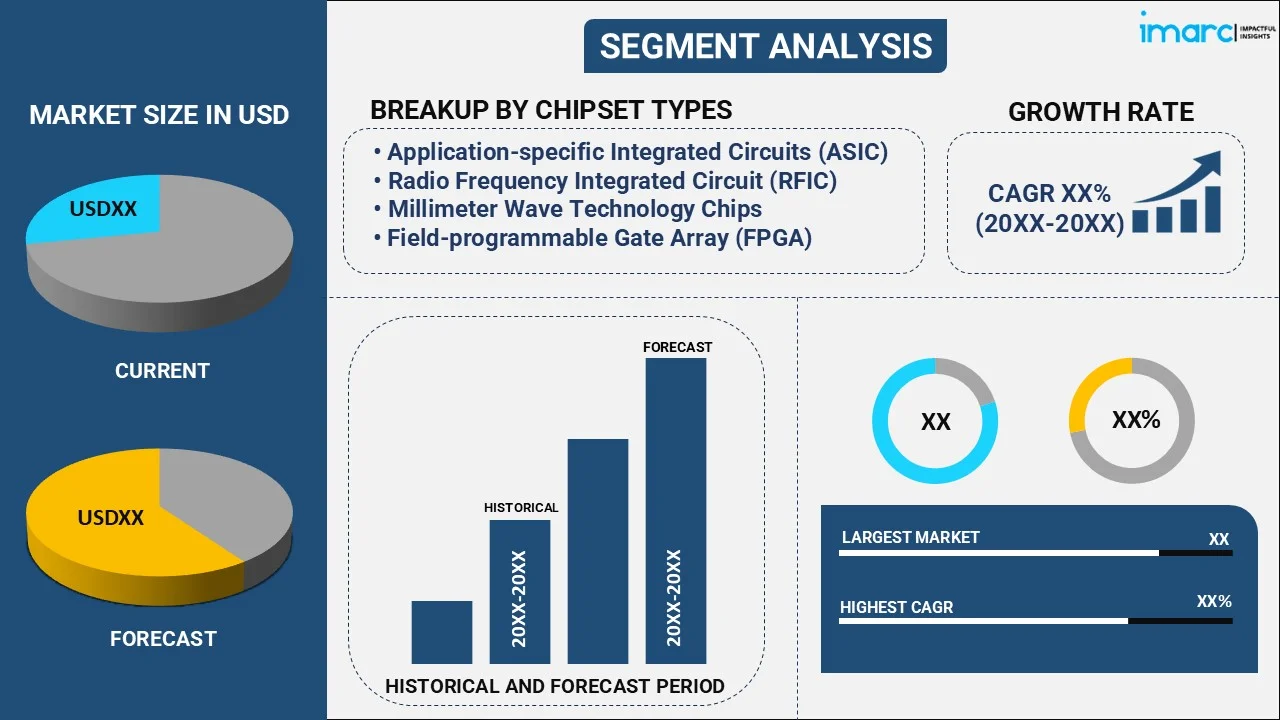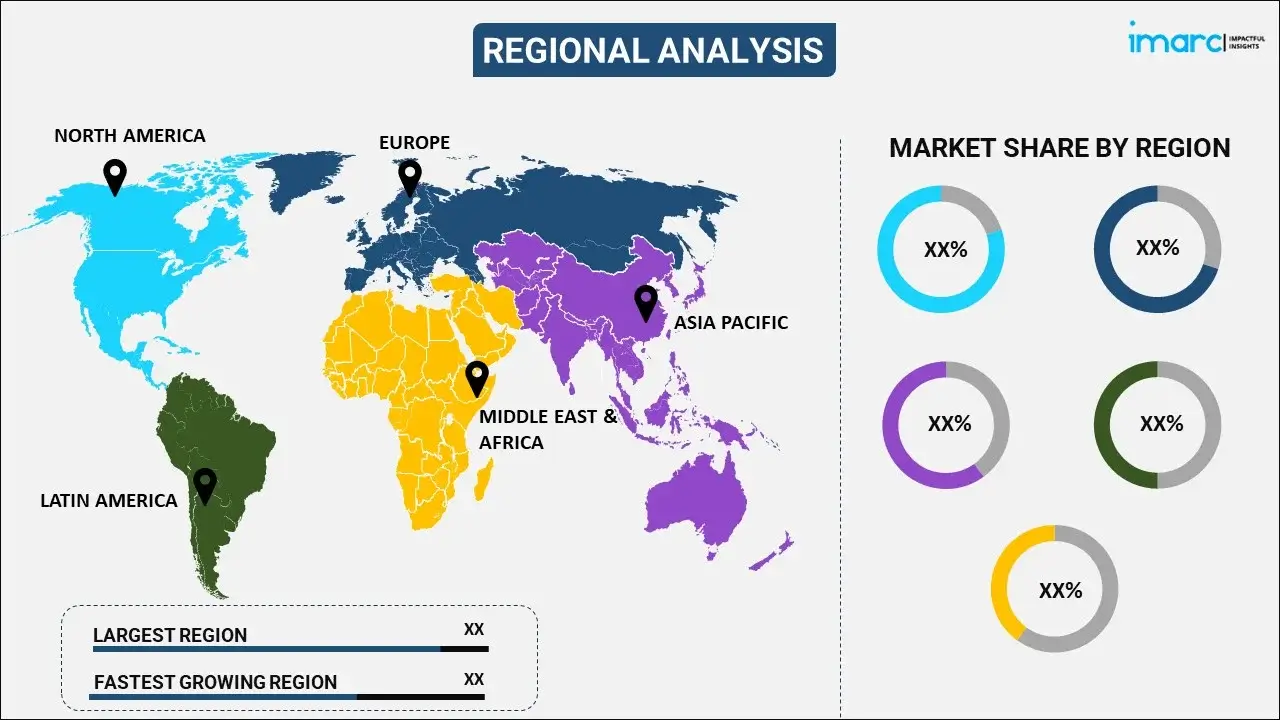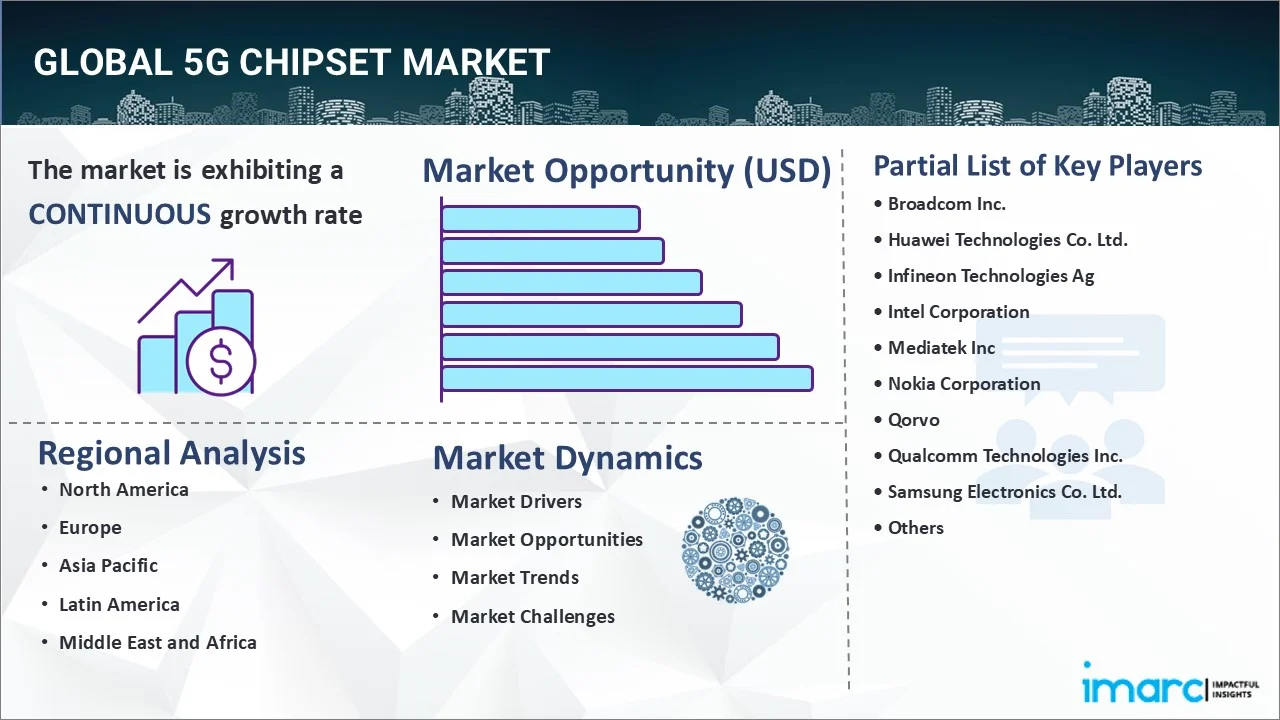
5G Chipset Market Report by Chipset Type (Application-Specific Integrated Circuits (ASIC), Radio Frequency Integrated Circuit (RFIC), Millimeter Wave Technology Chips, Field-Programmable Gate Array (FPGA)), Operational Frequency (Sub 6 GHz, Between 26 and 39 Ghz, Above 39 Ghz), End User (Consumer Electronics, Industrial Automation, Automotive and Transportation, Energy and Utilities, Healthcare, Retail, and Others), and Region 2025-2033
Global 5G Chipset Market:
The global 5G chipset market size reached USD 7.9 Billion in 2024. Looking forward, IMARC Group expects the market to reach USD 85.4 Billion by 2033, exhibiting a growth rate (CAGR) of 30.2% during 2025-2033. The market is experiencing steady growth driven by the escalating demand for high-speed internet and advanced data services across various sectors, the widespread adoption of IoT devices, and substantial investments and supportive government policies for 5G network deployment. Asia Pacific accounts for the largest 5G chipset market share in the world.
|
Report Attribute
|
Key Statistics
|
|---|---|
|
Base Year
|
2024 |
|
Forecast Years
|
2025-2033
|
|
Historical Years
|
2019-2024
|
| Market Size in 2024 | USD 7.9 Billion |
| Market Forecast in 2033 | USD 85.4 Billion |
| Market Growth Rate (2025-2033) | 30.2% |
Global 5G Chipset Market Analysis:
- Major Market Drivers: The escalating demand for high-speed internet and advanced data services is primarily driving the growth of the market. In addition to this, the widespread adoption of IoT devices, smart city initiatives, and the acceleration of industrial automation is also contributing to the market growth.
- Key Market Trends: 5G chipset market statistics, indicated that the growing trend towards the integration of 5G chipsets in consumer electronics, particularly smartphones, and in commercial sectors for IoT and industrial automation is augmenting the market growth. Moreover, the introduction of energy-efficient and cost-effective chipset solutions is creating a positive outlook for the future of the 5G chipset market.
- Geographical Trends: The Asia-Pacific region, particularly countries such as China and South Korea, holds the largest 5G chipset market share due to rapid network deployment and government support. This region has been at the forefront of 5G deployment, with extensive network rollouts and a high adoption rate of 5G-enabled devices.
- Competitive Landscape: Some of the leading players in the global 5G chipset industry include Broadcom Inc., Huawei Technologies Co., Ltd., Infineon Technologies Ag, Intel Corporation, Mediatek Inc., Nokia Corporation, Qorvo, Qualcomm Technologies, Inc., Samsung Electronics Co. Ltd., Xilinx Inc, among others.
- Challenges and Opportunities: The market faces challenges, such as high infrastructure costs and the need for standardization across regions, which may hamper the 5G chipset market price. However, these challenges present opportunities for innovation in cost-effective solutions and the development of universal standards to foster global market expansion. Government initiatives in various countries offer substantial opportunities for market growth through investments and supportive policies.
Global 5G Chipset Market Trends:
Increasing Demand for High-Speed Internet and Data Services
The global market is significantly driven by the escalating demand for high-speed internet and advanced data services. Furthermore, the proliferation of IoT devices, smart cities, and industrial automation is also augmenting the need for 5G chipsets. Several smart city projects and initiatives are underway around the world, and it is expected that by 2025, there will be around 30 global smart cities, with half of these located in North America and Europe. These steps are supported by global investments, which, according to the OECD, are expected to total USD 1.8 Trillion in urban infrastructure projects between 2010 and 2030. This, in turn, is driving the demand for 5G chipsets for smart city connectivity applications. Moreover, the rapid expansion of mobile networks and increasing smartphone penetration are also bolstering the 5G chipset market value. The global number of smartphone users was forecast to continuously increase between 2024 and 2029 by, in total, 1.5 billion users (+30.6 %). After the fifteenth consecutive increasing year, the smartphone user base is estimated to reach 6.4 billion users and, therefore, a new peak in 2029. Furthermore, the growing appetite for streaming services, online gaming, and real-time data access necessitates robust and fast connectivity solutions, which is anticipated to propel the 5G chipset market demand.
Technological Advancements in Semiconductor and Telecommunication Industries
Ongoing technological advancements in the semiconductor and telecommunication sectors are also propelling the growth of the market. Continuous innovation in chipset design, including the development of smaller, more efficient, and cost-effective components, is positively impacting the 5G chipset market outlook. Additionally, various telecom operators are acquiring spectrums to increase their 5G connection coverage. For instance, in August 2022, in India's first 5G spectrum auction, Airtel paid INR 43,084 crore for 19,800 MHz spectrum. In the past 20 years, spectrum bands 900 MHz, 2100 MHz, 1800 MHz, 3300 MHz, and 26 GHz have been acquired through auctions. It obtained a pan-India footprint in the 3.5 GHz and 26 GHz bands. According to the company, this is the ideal spectrum bank for the best 5G experience, with 100x capacity enhancement done strategically at the lowest cost. Moreover, various key market players are also collaborating with each other to improve 5G infrastructure. For example, ABB and Ericsson collaborated to realize Thailand's Industry 4.0 ambition and facilitate future flexible production with automation systems and wireless communications. The focus areas include ABB's Robotics & Discrete Automation, Industrial Automation, and Motion business areas and ABB Ability TM Platform Services. The collaboration covers 5G-enabled Augmented Reality Lenses for remote commissioning in manufacturing environments in addition to global NB-IoT connected motors and drives through Ericsson Communication Service Provider partners and its IoT-Accelerator platform. Furthermore, advances in semiconductor technology, such as the transition to smaller nanometre process nodes, are enhancing their performance and energy efficiency, which is anticipated to propel the 5G chipset market growth.
Government Initiatives and Investment in 5G Infrastructure
Government policies and investments are playing a pivotal role in driving the 5G chipset market price. Numerous countries are actively promoting the deployment of 5G networks as part of their digital transformation agendas, providing financial and regulatory support to accelerate this process. For instance, according to IBEF data, the Government of India has set an ambitious target of increasing manufacturing output contribution to GDP to 25% by 2025, up from 16%. The Smart Advanced Manufacturing and Rapid Transformation Hub (SAMARTH) Udyog Bharat 4.0 initiative aims to raise awareness of Industry 4.0 in the Indian manufacturing industry and assist stakeholders in addressing smart manufacturing challenges. Furthermore, governments are facilitating the allocation of 5G spectrum bands, crucial for the efficient operation of 5G networks and, by extension, the performance of 5G chipsets. This is anticipated to positively impact the future of 5G chipset market in the coming years.
5G Chipset Industry Segmentation:
IMARC Group provides an analysis of the key trends in each segment of the market, along with forecasts at the global, regional, and country levels for 2025-2033. Our report has categorized the market based on chipset type, operational frequency, and end user.
Breakup by Chipset Type:

- Application-specific Integrated Circuits (ASIC)
- Radio Frequency Integrated Circuit (RFIC)
- Millimeter Wave Technology Chips
- Field-programmable Gate Array (FPGA)
Application-specific integrated circuits (ASIC) dominate the market
The report has provided a detailed breakup and analysis of the market based on the chipset type. This includes application-specific integrated circuits (ASIC), radio frequency integrated circuit (RFIC), millimeter wave technology chips, and field-programmable gate array (FPGA). According to the report, application-specific integrated circuits (ASIC) represented the largest segment.
The ASIC segment holds the largest share of the market. These chips are custom-designed for specific applications, making them highly efficient for dedicated tasks. In the context of 5G, ASICs are predominantly used in network infrastructure and high-performance computing applications where efficiency and speed are critical. Their ability to provide tailored solutions for complex processes, such as signal processing and data handling in 5G networks, makes them a preferred choice. Despite their higher upfront development cost, their optimized performance and lower operational costs in the long term contribute significantly to their market dominance.
Breakup by Operational Frequency:
- Sub 6 GHz
- Between 26 and 39 Ghz
- Above 39 Ghz
Sub 6 GHz holds the largest share in the market
A detailed breakup and analysis of the market based on the operational frequency has also been provided in the report. This includes sub 6 GHz, Between 26 and 39 Ghz, and above 39 GHz. According to the report, sub 6 GHz accounted for the largest market share.
The sub 6 GHz segment is currently the largest in the global market. This frequency range is crucial for providing widespread coverage and better penetration through obstacles, making it ideal for urban and suburban areas. Chipsets operating in this spectrum are fundamental to ensuring broad 5G network accessibility, especially in regions where dense building construction can impede higher frequency signals. These chipsets support a balance between coverage and data rate, making them suitable for a wide array of consumer devices and industrial applications.
Breakup by End User:
- Consumer Electronics
- Industrial Automation
- Automotive and Transportation
- Energy and Utilities
- Healthcare
- Retail
- Others
Consumer electronics hold the largest share of the market
A detailed breakup and analysis of the market based on the end-user have also been provided in the report. This includes consumer electronics, industrial automation, automotive and transportation, energy and utilities, healthcare, retail, and others. According to the report, consumer electronics accounted for the largest market share.
The consumer electronics segment holds the largest share of the market, driven by the rapid adoption of 5G technology in smartphones, tablets, wearables, and smart home devices. According to the Cisco Annual Internet Report, the average smartphone connection speed in the United States was 81.1 Mbps as of 2023, up from 19.2 Mbps in 2018, a 4.2-fold growth (33% CAGR). Alongside 5G rollouts, operators are also pursuing ambitious network transformation strategies. Moreover, numerous consumer electronic operators are increasingly collaborating with 5G providers, which is creating a positive outlook for the overall market. For instance, 18 global telecom and consumer device makers partnered with US-based Qualcomm for their 5G chipset. Such innovations and advancements will continue to cater to the growth of this segment.
Breakup by Region:

- North America
- United States
- Canada
- Asia-Pacific
- China
- Japan
- India
- South Korea
- Australia
- Indonesia
- Others
- Europe
- Germany
- France
- United Kingdom
- Italy
- Spain
- Russia
- Others
- Latin America
- Brazil
- Mexico
- Others
- Middle East and Africa
Asia Pacific leads the market, accounting for the largest 5G chipset market share.
The market research report has also provided a comprehensive analysis of all the major regional markets, which include North America (the United States and Canada); Asia Pacific (China, Japan, India, South Korea, Australia, Indonesia, and others); Europe (Germany, France, the United Kingdom, Italy, Spain, and others); Latin America (Brazil, Mexico, and others); and the Middle East and Africa. According to the report, Asia Pacific accounted for the largest market share.
Asia Pacific (APAC) is the largest segment in the market, primarily driven by rapid technological advancements and strong government support in countries such as China, South Korea, and Japan. This region has been at the forefront of 5G deployment, with extensive network rollouts and a high adoption rate of 5G-enabled devices. Further, South Korea also boasts one of the highest 5G performances in APAC, exceeded only by Malaysia. The two countries are home to the leading cities in terms of 5G performance, with Seoul having the fastest download speed and Kuala Lumpur the fastest upload speed among major cities in the region. South Korea was the first country worldwide to launch 5G services in April 2019.
Leading Key Players in the 5G Chipset Industry:
The market research report has provided a comprehensive analysis of the competitive landscape and 5G chipset market overview. Detailed profiles of all major companies have also been provided. Some of the key players in the market include:
- Broadcom Inc
- Huawei Technologies Co., Ltd.
- Infineon Technologies Ag
- Intel Corporation
- Mediatek Inc
- Nokia Corporation
- Qorvo
- Qualcomm Technologies, Inc.
- Samsung Electronics Co. Ltd.
- Xilinx Inc.
(Please note that this is only a partial list of the key players, and the complete list is provided in the report.)
Global 5G Chipset Market News:
- February 2024 - Apple extends its agreement with Qualcomm for 5G modem chips until 2027. Qualcomm CEO Cristiano Amon, in an interview with CNBC, has confirmed that Apple has agreed to extend its patent license agreement related to the 5G modem through March 2027.
- Nov 2023 - MediaTek launched Dimensity 8300 5G chipset with genAI capabilities. The chipset is based on TSMC's second-generation 4nm process and has an octa-core CPU comprising four Arm Cortex-A715 cores and four Cortex-A510 cores built on Arm's v9 CPU architecture. It is paired with the Mali-G615 MC6 GPU. The Dimensity 8300 unlocks new possibilities for the premium smartphone segment, offering users in-hand AI, hyper-realistic entertainment opportunities, and seamless connectivity.
- November 2023 - Viettel High Tech developed its own 5G chipset. The 5G DFE (digital front end) chip can perform one quadrillion calculations per second.
Global 5G Chipset Market Report Scope:
| Report Features | Details |
|---|---|
| Base Year of the Analysis | 2024 |
| Historical Period | 2019-2024 |
| Forecast Period | 2025-2033 |
| Units | Billion USD |
| Scope of the Report | Exploration of Historical Trends and Market Outlook, Industry Catalysts and Challenges, Segment-Wise Historical and Predictive Market Assessment:
|
| Chipset Types Covered | Application-Specific Integrated Circuits (ASIC), Radio Frequency Integrated Circuit (RFIC), Millimeter Wave Technology Chips, Field-Programmable Gate Array (FPGA) |
| Operational Frequencies Covered | Sub 6 GHz, Between 26 and 39 Ghz, Above 39 Ghz |
| End Users Covered | Consumer Electronics, Industrial Automation, Automotive and Transportation, Energy and Utilities, Healthcare, Retail, Others |
| Regions Covered | Asia Pacific, Europe, North America, Latin America, Middle East and Africa |
| Countries Covered | United States, Canada, Germany, France, United Kingdom, Italy, Spain, Russia, China, Japan, India, South Korea, Australia, Indonesia, Brazil, Mexico |
| Companies Covered | Broadcom Inc, Huawei Technologies Co., Ltd., Infineon Technologies Ag, Intel Corporation, Mediatek Inc, Nokia Corporation, Qorvo, Qualcomm Technologies, Inc., Samsung Electronics Co. Ltd., Xilinx Inc, etc. |
| Customization Scope | 10% Free Customization |
| Post-Sale Analyst Support | 10-12 Weeks |
| Delivery Format | PDF and Excel through Email (We can also provide the editable version of the report in PPT/Word format on special request) |
Key Benefits for Stakeholders:
- IMARC’s industry report offers a comprehensive quantitative analysis of various market segments, historical and current market trends, market forecasts, and dynamics of the 5G chipset market from 2019-2033.
- The research report provides the latest information on the market drivers, challenges, and opportunities in the global 5G chipset market.
- The study maps the leading, as well as the fastest-growing, regional markets. It further enables stakeholders to identify the key country-level markets within each region.
- Porter's five forces analysis assists stakeholders in assessing the impact of new entrants, competitive rivalry, supplier power, buyer power, and the threat of substitution. It helps stakeholders to analyze the level of competition within the 5G chipset industry and its attractiveness.
- The competitive landscape allows stakeholders to understand their competitive environment and provides insight into the current positions of key players in the market.
Key Questions Answered in This Report
The global 5G chipset market was valued at USD 7.9 Billion in 2024.
We expect the global 5G chipset market to exhibit a CAGR of 30.2% during 2025-2033.
The rising applications of 5G chipset in airplanes, high-speed rails, and ships to improve the speed, latency, reliability, and efficiency of 5G networks are primarily driving the 5G chipset market revenue.
The sudden outbreak of the COVID-19 pandemic has led to the growing demand for 5G chipset to aid in enabling video-conferencing, live streaming, telemedicine, and various business applications during the implementation of stringent lockdown regulations across several nations.
Based on the chipset type, the global 5G chipset market can be segmented into Application-Specific Integrated Circuits (ASIC), Radio Frequency Integrated Circuit (RFIC), millimeter wave technology chips, and Field-Programmable Gate Array (FPGA). Currently, Application-Specific Integrated Circuits (ASIC) hold the majority of the total market share.
Based on the operational frequency, the global 5G chipset market has been divided into sub 6GHz, Between 26 and 39 Ghz, and above 39 Ghz. Among these, sub 6GHz exhibits a clear dominance in the market.
Based on the end user, the global 5G chipset market can be categorized into consumer electronics, industrial automation, automotive and transportation, energy and utilities, healthcare, retail, and others. Currently, the consumer electronics industry accounts for the largest market share.
On a regional level, the market has been classified into North America, Asia-Pacific, Europe, Latin America, and Middle East and Africa, where Asia-Pacific currently dominates the global market.
Some of the major players in the global 5G chipset market include Broadcom Inc, Huawei Technologies Co., Ltd., Infineon Technologies Ag, Intel Corporation, Mediatek Inc, Nokia Corporation, Qorvo, Qualcomm Technologies, Inc., Samsung Electronics Co. Ltd., and Xilinx Inc.
Need more help?
- Speak to our experienced analysts for insights on the current market scenarios.
- Include additional segments and countries to customize the report as per your requirement.
- Gain an unparalleled competitive advantage in your domain by understanding how to utilize the report and positively impacting your operations and revenue.
- For further assistance, please connect with our analysts.

 Inquire Before Buying
Inquire Before Buying
 Speak to an Analyst
Speak to an Analyst
 Request Brochure
Request Brochure
 Request Customization
Request Customization




.webp)




.webp)












